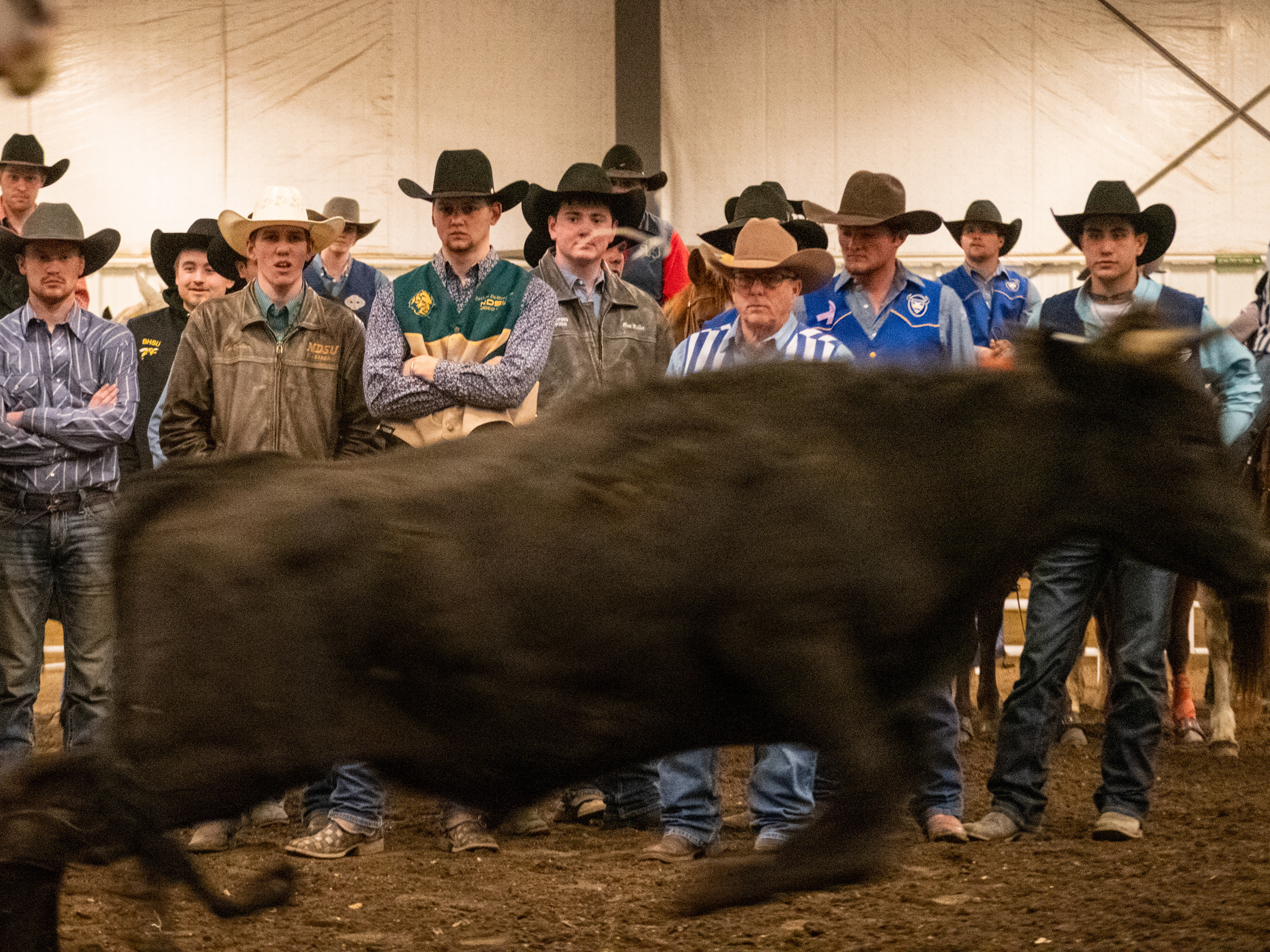Candice grew up working on the family farm and graduated from Oklahoma State University in 2004 with a bachelor's in biosystems engineering. After working for more than 18 years at John Deere, she returned to the family business in January 2020.
Candice Engler continues to work at her computer on Friday, Sept. 22, 2023, at the Johnson Brothers workshop near Ankeny, Iowa. The farm started harvesting its soybean crop at the beginning of the week but had to pause the operation due to scattered rain throughout the week.
Matt Poling rides and directs the skid steer loader that Eric Stall is driving on Friday, Sept. 22, 2023, at the Johnson Brothers workshop near Ankeny, Iowa. The two are taking the combine’s corn head to the main shop to clean it and look at the oil levels.
Eric Stall blasts dust and debris off of the combine’s corn head with an air hose on Friday, Sept. 22, 2023, at the Johnson Brothers workshop near Ankeny, Iowa.
Candice Engler drives the combine through a field of soybeans during the fall harvest on Friday, Oct. 6, 2023, near Woodward, Iowa. “It’s getting harder and harder to control weeds,” Engler stated. “Weeds are adapting to the chemicals we’re using.”
Jay Rauk and his son Collin operate the Johnson Brothers combine, collecting soybeans during the fall harvest as the sun sets on Wednesday, Oct. 4, 2023, south of Slater, Iowa.
“If I go with the row, the same little knife is having to try to cut all the time, … and the certain [sickle sections] would get duller," Candice Engler said.
Instead of moving straight along the planted rows, the combine crosses the soybean fields at an angle. This strategy helps prevent “push,” which is when the combine rips an entire plant out of the ground because a sickle cuts too slowly or becomes dull, “pushing” a pile of plants and soil along the ground.
“We found that if you cut at an angle … each sickle gets a little bit of a break to clean off … before it has to cut the next [plant],” Engler said.
Candice Engler works on replacing a sickle section on the combine’s bean head during the fall harvest on Friday, Oct. 6, 2023, near Woodward, Iowa.
Josie, 6, left, and her mom, Candice Engler, right, drive a combine through a field of soybeans during the fall harvest on Friday, Oct. 6, 2023, near Woodward, Iowa. “Just back and forth and back and forth,” Engler says.
Jay Rauk and his son Collin, left, dump their load of soybeans into the grain cart, right, operated by Matt Poling, during the fall harvest on Wednesday, Oct. 4, 2023, south of Slater, Iowa.
“There are a lot of different paths you can take,” Candice Engler said. “There is a neighbor … he farms from a desk. He has hired help that does the actual work work and he manages it.”
Engler said some agronomy students gain outside experience in different aspects of farming, such as seed sales. This can help them pick up ag-adjacent jobs outside of their tractors, as creating a viable farm operation that can sustain a family is becoming more and more difficult.
“It takes quite a few acres to support a family unless you find a way to make those acres unique,” Engler said. “I’ve got one friend, and they’re doing some certified organic stuff, and it’s painful to watch.”
Matt Poling operates the Johnson Bros. grain cart, collecting soybeans during the fall harvest as the sun sets on Wednesday, Oct. 4, 2023, south of Slater, Iowa.
Candice Engler attempts to call a nearby dealership that closed for the day thirty minutes prior to see if they are still open after a rubber belt on the combine snapped during the fall harvest on Friday, Oct. 6, 2023, near Woodward, Iowa. Engler does not own a spare belt and will need to replace it tomorrow morning. “And just like that, our evening’s over,” Engler states. “All in a normal part of harvest. This is the third pretty major fix needed this week.”
“Seventy percent of the days … I just really love what we do, and it’s fun. Thirty percent of the days, it’s a job, and it’s work,” Engler said.
However, the harvest season is when they see the payoff of their projects.
“It is kind of cool to see all the decisions you make and which ones work and don’t work, and this is the time of year where you find out if what you tried worked,” Engler said.
Matt Poling, left, and Bruce Johnson, right, lift a new auger tube into the Johnson Brothers combine grain tank during the fall harvest on Saturday, Oct. 7, 2023, near Woodward, Iowa. The previous auger and its tube on the combine sustained significant damage the night prior, requiring new parts.
Candice Engler fixes the tension of a spring for the unloading system during the fall harvest on Tuesday, Oct. 17, 2023, near Woodward, Iowa.
Candice Engler operates the Johnson Brothers combine during the fall harvest on Saturday morning, Oct. 21, 2023, near Ankeny, Iowa.
Corn from the Johnson Brothers truck spills into the pit during the fall harvest on Saturday, Oct. 21, 2023, at the Heartland Co-op facility near Elkhart, Iowa.
Candice Engler operates the Johnson Brothers combine during the fall harvest on Saturday, Oct. 21, 2023, near Ankeny, Iowa.
Troy Sjaardema opens the final hopper on the grain truck trailer to release the remaining corn during the fall harvest on Saturday, Oct. 21, 2023, at the Johnson Brothers main shop near Polk City, Iowa.
Troy Sjaardema climbs the steps of one of the Johnson Brothers grain bins during the fall harvest on Saturday, Oct. 21, 2023, at the Johnson Brothers main shop near Polk City, Iowa.
As Bruce Johnson, right, begins to eat his burger for lunch, his granddaughter Josie Engler, 6, left, climbs the back tire of his truck during the fall harvest on Saturday, Oct. 21, 2023, near Ankeny, Iowa.
Besides the weather resulting in an almost nonstop harvest, in general, it was smooth, she said. Small hiccups emerged along the way, with a few breakdowns and repairs, but those are to be expected.
Across the board, some fields had better yields, most were average, and a few were poor.
“Some things made a difference; some things I don't think made enough of a difference,” Engler said about the few products they tested.



